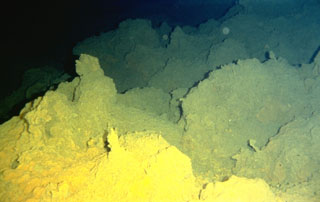Report on Kama'ehuakanaloa (United States) — May 1995
Bulletin of the Global Volcanism Network, vol. 20, no. 5 (May 1995)
Managing Editor: Edward Venzke.
Kama'ehuakanaloa (United States) Earthquake swarm
Please cite this report as:
Global Volcanism Program, 1995. Report on Kama'ehuakanaloa (United States) (Venzke, E., ed.). Bulletin of the Global Volcanism Network, 20:5. Smithsonian Institution. https://doi.org/10.5479/si.GVP.BGVN199505-332000
Kama'ehuakanaloa
United States
18.92°N, 155.27°W; summit elev. -975 m
All times are local (unless otherwise noted)
An earthquake swarm late on 27 April consisted of 75 events. Only 42 of these were large enough to process for locations. Seismic events from Lōʻihi continued through the end of April, with the largest a M 2.9. Seismic swarms are fairly common at Lōʻihi, and were last reported on 11 July and 12 October 1993 (BGVN 18:07 and 18:10), and 19 December 1991 (BGVN 16:12). This youngest volcano of the Hawaiian chain lies ~35 km SE of Hawaii. The summit region is dotted with numerous lava cones, and the abundant fresh, sediment-free lavas attest to its youthful age. Seismicity indicates that the plumbing system is distinct from that of Kīlauea, 55 km N.
Geological Summary. The Kama’ehuakanaloa seamount, previously known as Loihi, lies about 35 km off the SE coast of the island of Hawaii. This youngest volcano of the Hawaiian chain has an elongated morphology dominated by two curving rift zones extending north and south of the summit. The summit region contains a caldera about 3 x 4 km and exhibits numerous lava cones, the highest of which is about 975 m below the ocean surface. The summit platform also includes two well-defined pit craters, sediment-free glassy lava, and low-temperature hydrothermal venting. An arcuate chain of small cones on the western edge of the summit extends north and south of the pit craters and merges into the crests prominent rift zones. Seismicity indicates a magmatic system distinct from that of Kilauea. During 1996 a new pit crater formed at the summit, and lava flows were erupted. Continued volcanism is expected to eventually build a new island; time estimates for the summit to reach the ocean surface range from roughly 10,000 to 100,000 years.
Information Contacts: Paul Okubo, USGS Hawaiian Volcano Observatory (HVO), Hawaii Volcanoes National Park, HI 96718, USA.

